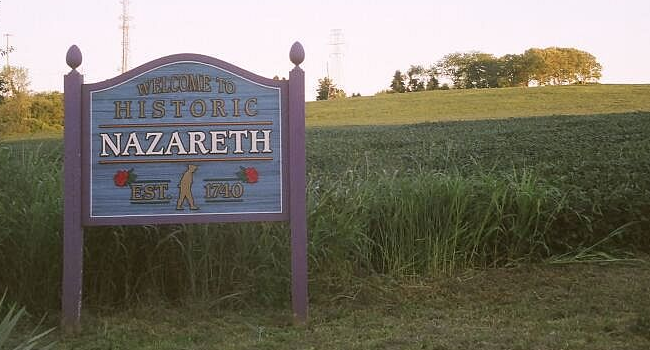The Moore Township Zoning Hearing Board met Wednesday, June 6 to hear the Water’s Edge at Wind Gap LLC Industrial Development for Warehouse Use property proposal appeal of the Zoning Officer’s determinations. The appeal challenges the substantive validity of various sections of the township’s zoning ordinance and zoning officer determinations.
Attorney Marc B. Kaplin of Kaplin Stewart Attorneys at Law represented the applicant at the hearing and called Stephen M. Walsh from Dynamic Engineering Consultants as a witness and expert engineer in zoning land development and civil engineering during the presentation.
Kaplin began with background information on the Water’s Edge at Wind Gap land development plans. The plans propose the development of two industrial warehouse buildings on the 51.12 acres of land at 235 Moorestown Road, which was acquired from the Southmoore Golf Course in December 2021 for $2.63 million.
Walsh presented aerial views of the land, showing that it is currently being used as a golf course with a separate existing parcel for the single-family dwelling associated with the golf course. Water’s Edge plans to consolidate the two parcels of land and demolish the buildings in order to build two industrial warehouses that total 488,150 square feet. The proposal for building one will be substantially bigger at 347,750 square feet and building two will be 140,400 square feet.
Walsh shared that an expanded on-lot septic system is proposed for the development, as well as frontage improvements that include landscaping, lighting, sidewalks, truck courts consisting of loading facilities against the building, truck staging, and parking areas removed from the building that allow trucks to wait or be staged before docking, and automobile parking facilities on opposing sides of the buildings. The entrance and exit for the development will be one single driveway on Moorestown Road with a proposed widening and additional turning lanes associated with the driveway.
Kaplin pointed out that the application submitted was in accordance with the original zoning ordinance, since the township amended section 200-22 of the warehouse ordinance in September 2021. Therefore, Kaplin explained, the Sept. 23, 2021 technical review letter from Horvath did not consider that the plans submitted were not subject to the township’s amended warehouse ordinance because they were submitted before the amendment was adopted.
“We read the review letters and determined if we could modify the plans for the proposed warehouse buildings to comply with issues raised throughout, we subsequently discussed many of the issues with Keystone to confirm that we understood fully the intent of all comments,” said Walsh.
Kaplin expressed that the Water’s Edge team also met with township consultants to address the issues raised in the September review letter and that they submitted a memorandum in November 2021 to obtain feedback from the township regarding the issues they were not able to resolve.
Water’s Edge submitted a revised application and plans on Dec. 8, 2021, which included revised materials, a point-by-point response letter to the Sept. 23 review, the memorandum outlining unresolved issues, a post-construction stormwater management plan, and an environmental and community impact statement.
The Water’s Edge development team received another review letter from Horvath dated Jan. 24, 2022, in response to the resubmission and revised materials. However, Horvath did not change his previous position regarding SALDO and zoning ordinance determinations.
Kaplin’s first determination challenge was for the woodlands protection versus the berm requirement along Moorestown Road and Jones Road. The section requires a 100-foot raised berm buffer yard along the front yard of any warehouse along the entire length of the property line with an average height of 14-feet along Jones Road and 4-feet along Moorestown Road. However, the environmental protection standards require a protection rate of 60%, with no more than 40% of those areas allowed to be cleared, thinned, or regraded, whereas the SALDO provides that no public improvements shall encroach into woodland areas and requires 80% protection of the woodlands.
Kaplin stated, “If it were not for the berm requirement, this plan would disturb less than 40% of the woodlands and would comply with zoning requirement” since the berm requirement is incompatible with the woodlands preservation requirement, making it “impossible to comply because it is inherently contradictory as applied to this property.”
“We are seeking this requirement be stricken or a variance from the provisions of the ordinance be granted, so Water’s Edge will not have to fill the berm,” said Kaplin.
Next, Kaplin challenged the Zoning Officer’s determination that the submission does not meet the zoning ordinance’s requirements for off-street parking and loading spaces. However, since the proposed warehouses do not have tenants at this time, the ordinance requirement of 696 parking spaces for building one and 281 parking spaces for building two would be a significantly high rate based on a conducted traffic study.
Instead, Water’s Edge proposed 253 parking spaces for building one and 128 for building two, which would exceed the required spaces when considering the 60 employees anticipated for building one at peak hour and 40 employees anticipated for building two as determined by the traffic study.
Per the zoning ordinance, building one would require 44 loading spaces and building two would require 18 spaces based on a rate of one space per 8,000 square feet. However, Water’s Edge proposed 12 loading spaces situated on the southwest corner of building one and 32 loading spaces on the entire side of building two due to the configuration of the buildings. Walsh expressed that the traffic study anticipated 11 trucks at peak hour, which is less than the 12 they proposed for building one, and that both parking and loading spaces are well within these ratios on the plan as anticipated by the traffic study.
Next, Kaplin addressed Keystone’s complaint that Water’s Edge failed to describe a particular use for the proposed warehouses in their application. The Zoning Officer determined that the submitted documents do not meet the minimum requirements of this section because the applicants fail to provide sufficient detail for a particular user. Walsh stated that this requirement is impossible to comply with because a proposed user is not identified at the land development stage.
Kaplin requested the board overrule the determination regarding the particular use or user, and subsequently rule that this information is not required at this time.
Following, Kaplin brought up the requirement for an off-site traffic analysis that analyzes all streets within two miles of the property’s boundaries. Kaplin stated that the Zoning Officer requested Water’s Edge study the 512 and 248 intersections of Bath Borough, which are not within the township and that PennDOT did not request this study. Kaplin suggested the board overrule the Zoning Officer’s determination requiring Water’s Edge to submit an intersection traffic study of two miles around the property’s boundaries.
Next, Kaplin addressed the proposed lighting plan for various areas of the development that were submitted based on standards outlined by the Illuminating Engineering Society, adding that all parking areas are illuminated in the plans to those standards since the zoning ordinance does not list a quantifiable criterion or provide references. Walsh included that the proposed warehouses will not need to illuminate truck work areas because they are not intended for pedestrian use. Therefore, Water’s Edge is asking the board to overrule the Zoning Officer’s determination that states the plans do not adequately illuminate intended areas for safe pedestrian and vehicular movement.
In regard to man-made versus naturally occurring steep slopes, Water’s Edge plans to level parts of the property in order to build, which will minimize stormwater run-off and erosion. Additionally, Walsh explained the disturbance of the man-made steep slopes will not alter the preservation of the environment. For this reason, Water’s Edge claims that the man-made steep slopes are exempt from preservation requirements and that the plans comply with applicable slope disturbance requirements.
Kaplin requested the board look to the SALDO for direction on this matter and overrule the determination made by the Zoning Officer because the applicants do not agree that these particular man-made steep slopes should be regulated.
Kaplin expressed that the development is prohibited from using Jones Road for warehouse improvements, so the proposed development will not be using Jones Road for warehouse traffic. Since there is a single-family dwelling on the north side of the property, the applicants were asked to realign Jones Road in the first review letter. Owner Jack Muschlitz agreed to realign Jones Road, but upon doing so, the township engineer determined that improvements were also needed for Monocacy Drive “to offset the cost of impact from the proposed development.”
Kaplin expressed that according to Municipalities Planning Code 503-A, the township does not have the authority to require improvements to off-site intersections and roads. Kaplin suggested the board overrule the Zoning Officer’s determination for off-site improvements to Jones Road.
Last, Kaplin presented an issue with the Zoning Officer’s determination of township SALDO Section Land Dedication Requirements for a non-residential development, which requires Water’s Edge to dedicate 2,000 square feet of open space or contribute $2,000 to the township in lieu of the dedication of land. However, the applicants stated that since no one will be inhabiting the land, this ordinance does not apply.
Kaplin asked the board to either “determine that the Zoning Officer is incorrect in applying this provision to this industrial development, or if the board sees that the ordinance does apply to this industrial development, we ask that it be invalidated as a violation of the enabling section of the recreational land use.”
Due to the length of the Water’s Edge at Wind Gap appeal presentation, the meeting will reconvene on Wednesday, August 17 at 6 p.m. at Moore Elementary School, located at 2835 Mountain View Dr.









